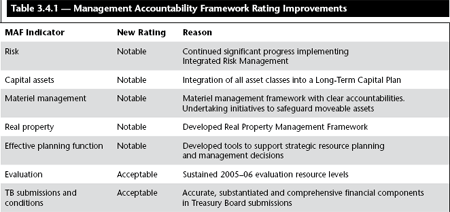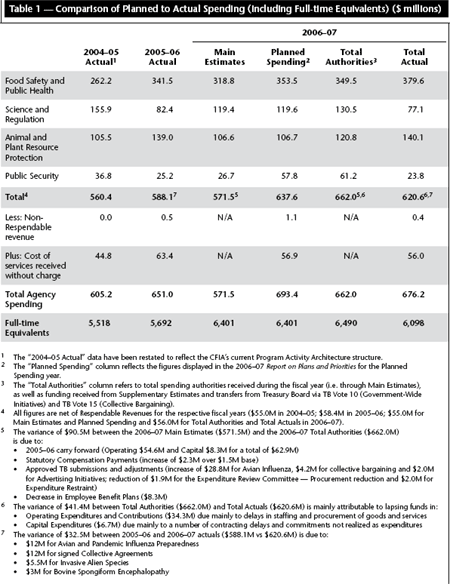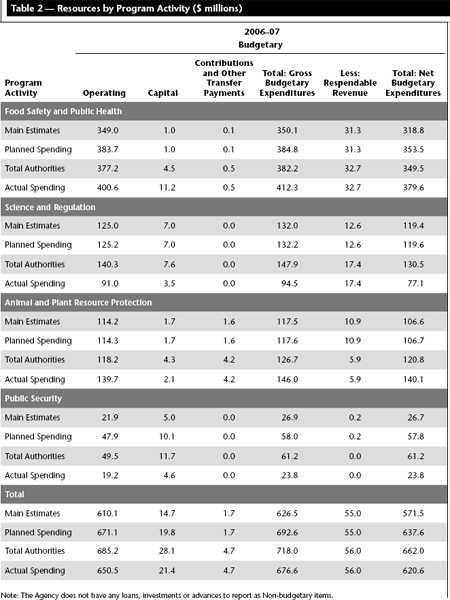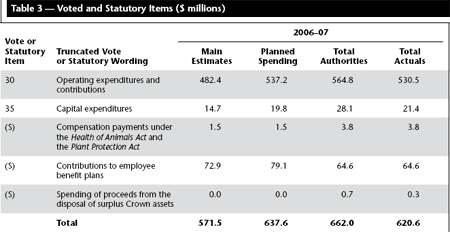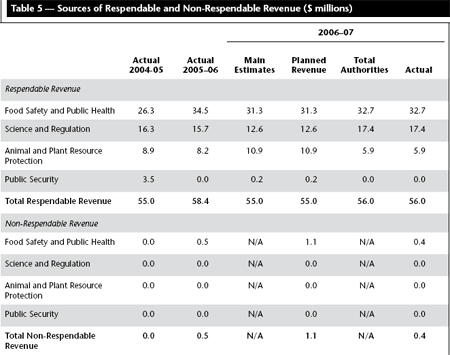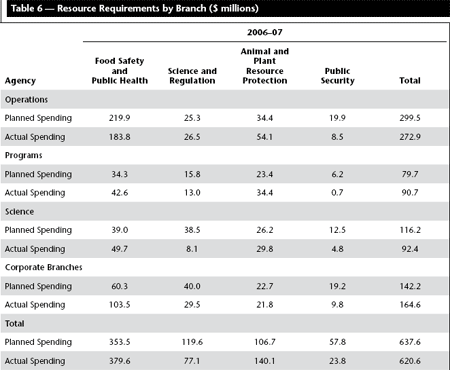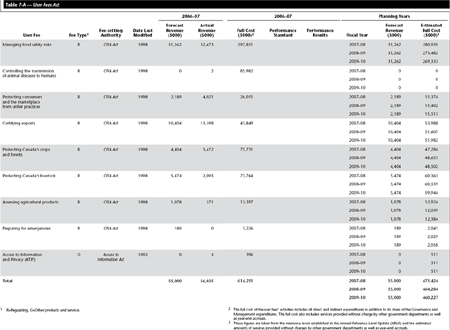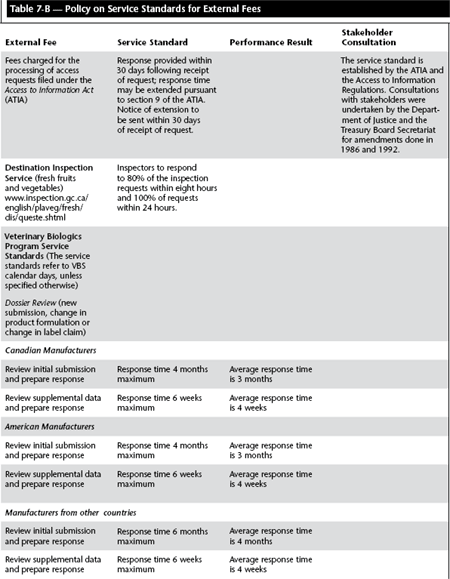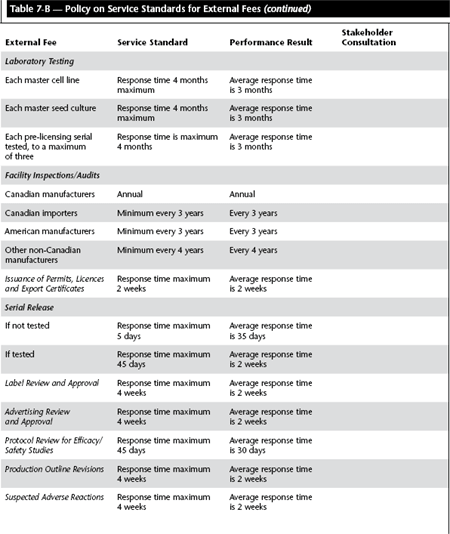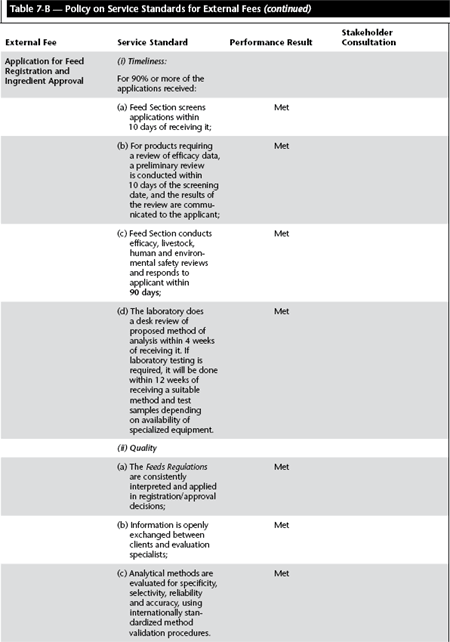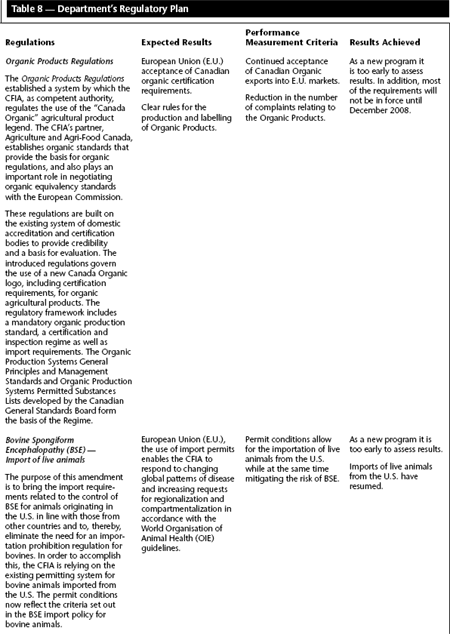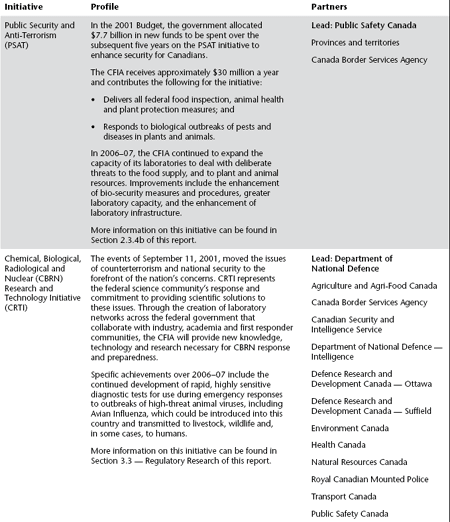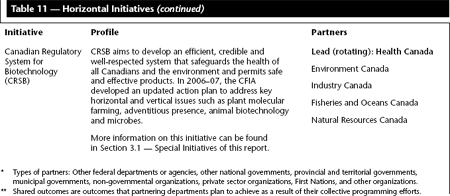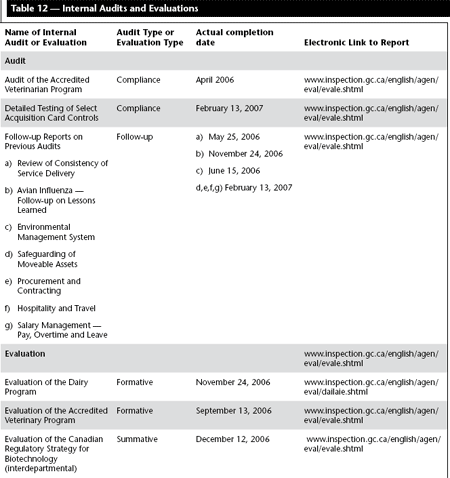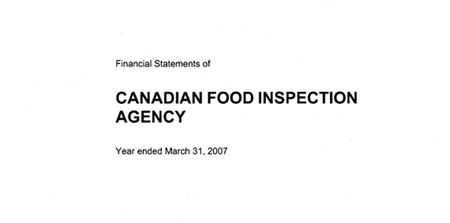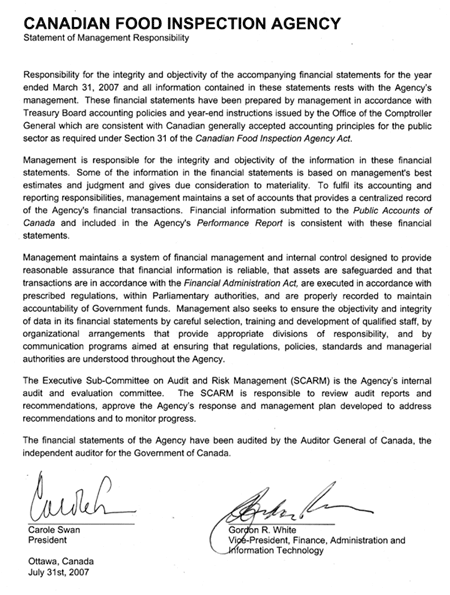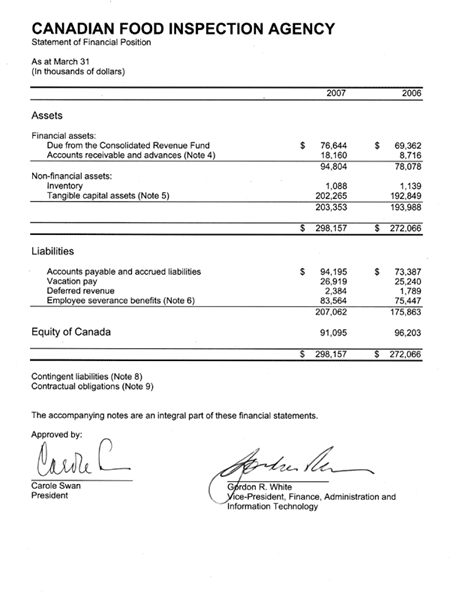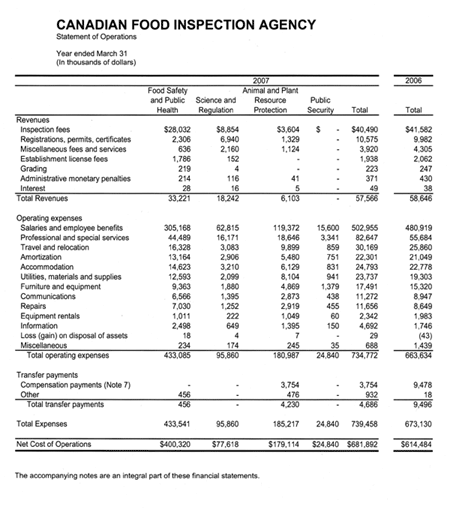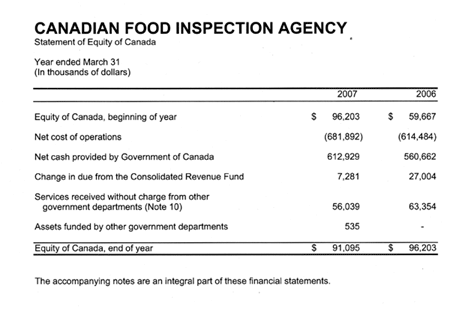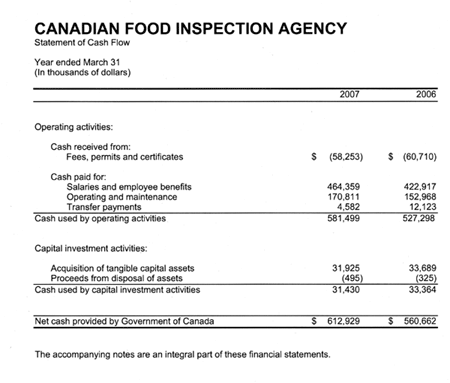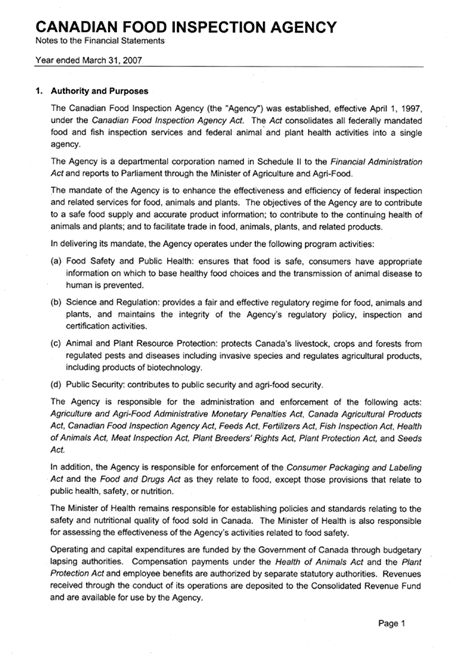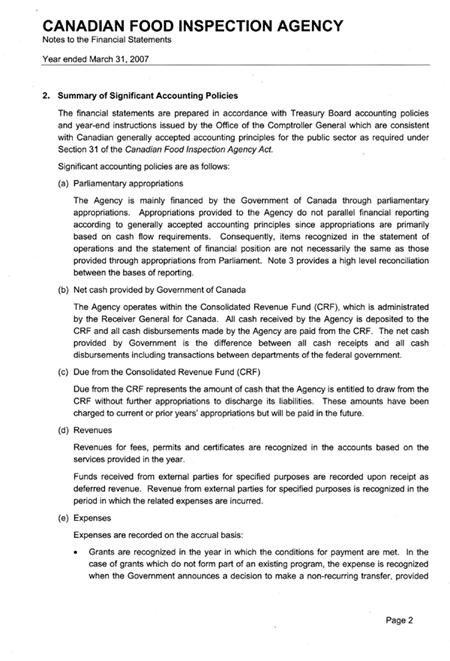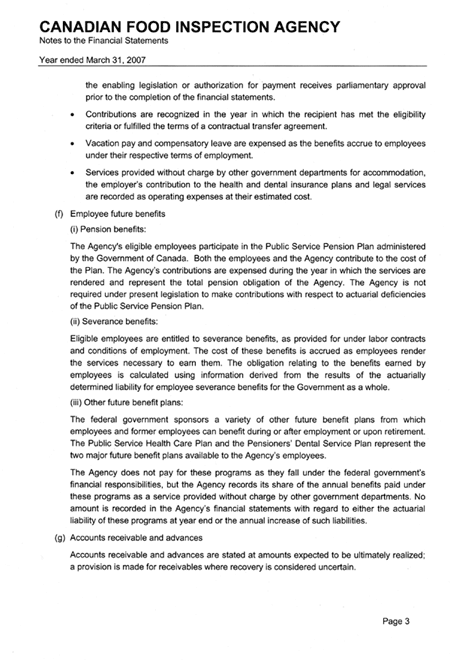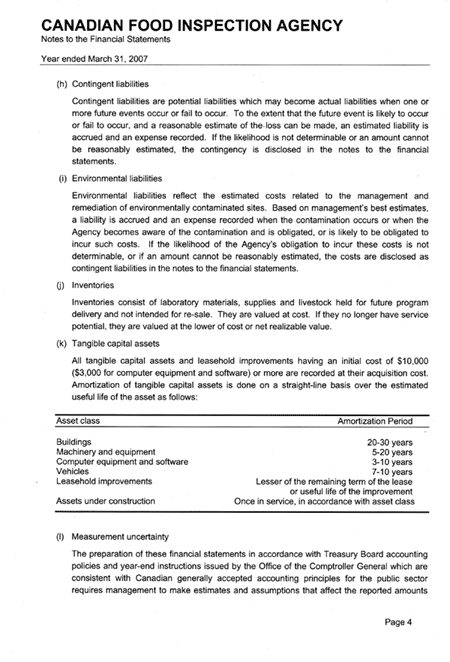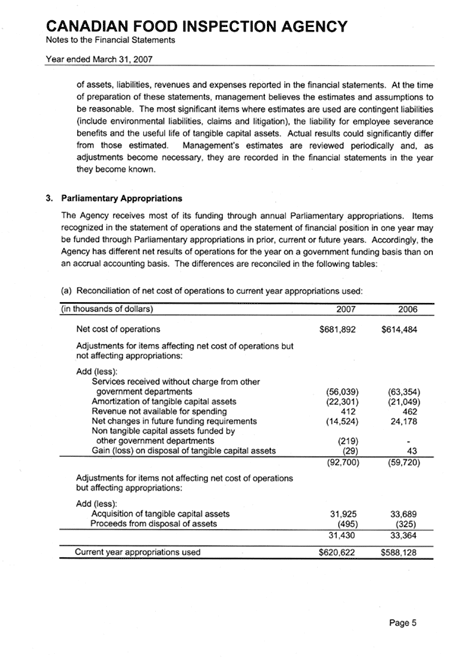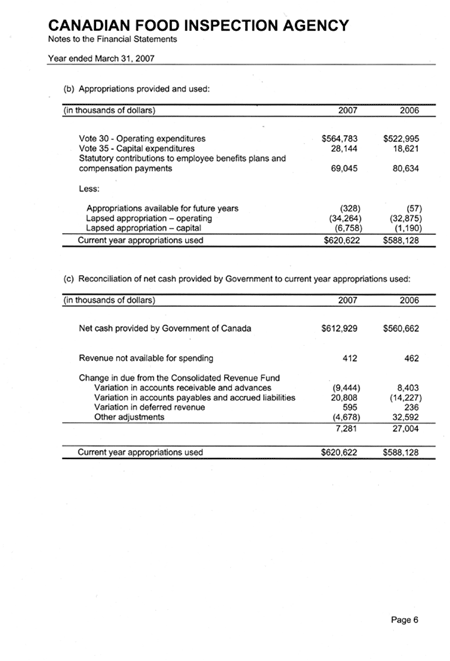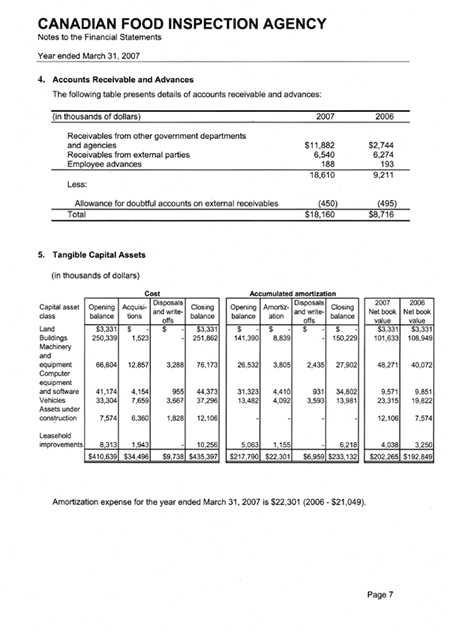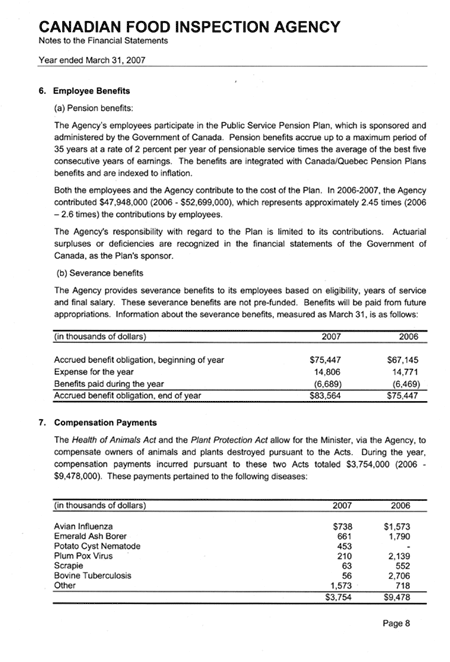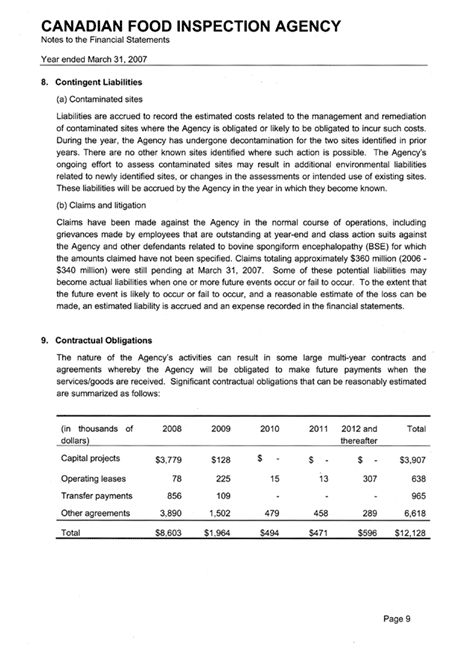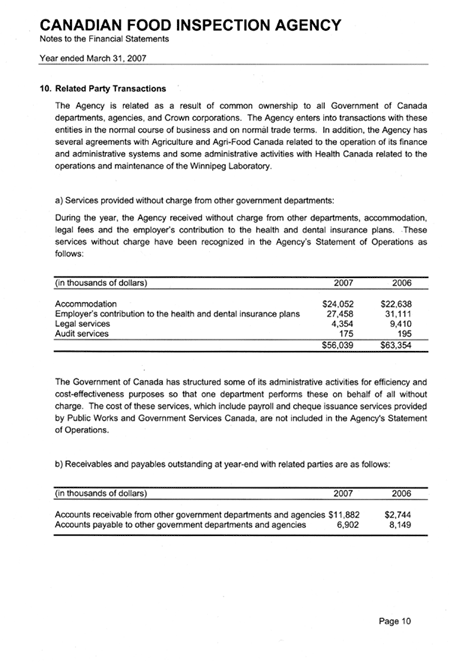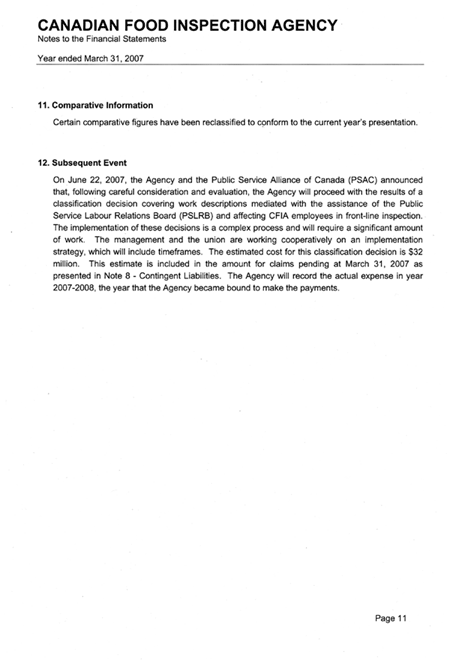Common menu bar links
Breadcrumb Trail
ARCHIVED - Canadian Food Inspection Agency
 This page has been archived.
This page has been archived.
Archived Content
Information identified as archived on the Web is for reference, research or recordkeeping purposes. It has not been altered or updated after the date of archiving. Web pages that are archived on the Web are not subject to the Government of Canada Web Standards. As per the Communications Policy of the Government of Canada, you can request alternate formats on the "Contact Us" page.
3. Supplementary Information
3.1 Special Initiatives
Moving Ahead on Key Challenges
Reporting on Special Initiatives: The Agency’s 2006–07 Report on Plans and Priorities reports on its key risks and challenges and sets out a plan to address these issues, namely through the work of Special Initiatives. These are longer term in nature and represent the strategic agenda of the CFIA.
In accordance with the Agency’s commitment to risk-based planning and the integration of risk management into all decision-making processes, the CFIA has identified 10 key challenges and risks to meeting its Strategic Outcomes. The CFIA recognizes that some of these risks, such as foodborne illness, zoonoses and the entry and spread of plant and animal diseases will likely
always exist. Accordingly, the CFIA’s goal is to reduce both the likelihood that these risks will occur and the consequences should they occur by improving its capacity to manage them. Any residual risks should be fully mitigated over time with careful planning and implementation of risk mitigation strategies. The initiatives included in the following section, although organized
according to the PAA, directly contribute to the mitigation of key strategic risks. The risk mitigation strategies have been identified throughout this section with the following symbol ![]() .
.
STRATEGIC OUTCOME: Protection from preventable health risks related to food safety or the transmission of animal diseases to humans
|
Program Sub-Activity: Managing food safety risks Expected Result: Food leaving federally registered establishments for inter-provincial and export trade, or being imported, is safe and wholesome |
![]() Enhancing the consistency of import control programs
Enhancing the consistency of import control programs
Canadians consume a variety of foods from a wider range of sources than ever before. Managing food safety risks associated with imported commodities presents challenges that differ from domestically produced food. In 2006–07, the CFIA updated and promoted the Good Importing Practices for Food publication which had last been updated in 1998. This voluntary code of practice provides guidance to food importers on how to establish effective controls to ensure food safety, as well as how to ensure imported products meet Canadian regulatory requirements. Although some sections may not apply to every importer, the publication is intended for broad use across the industry. The publication will also prove useful for CFIA inspectors in assessing food import controls, and will help guide the CFIA in refining its inspection priorities.
![]() Continuing to expand and integrate the Hazard Analysis Critical Control Point (HACCP) approach
Continuing to expand and integrate the Hazard Analysis Critical Control Point (HACCP) approach
Hazard Analysis Critical Control Point (HACCP) is a systematic approach to identifying and assessing hazards and risks associated with a food operation and defining the means of their control. The HACCP system prevents food safety problems by applying control throughout the manufacturing process at stages identified as critical control points. These points permit operators to detect and control hazards before products are distributed. While voluntary in the past, HACCP systems became mandatory for all federally registered meat and poultry establishments in November 2005 and became mandatory for fish establishments in 1997, although it remains voluntary for other sectors.
In order for a meat establishment to be granted HACCP-recognition, the establishment must be proven to meet a variety of conditions outlined by regulation. As of the end of the 2006–07 reporting period all of the 771 federally registered meat and poultry establishments had been evaluated by the CFIA to ensure compliance with the requirement to adopt the HACCP approach.
|
Expected Result: Food safety incidents in nonfederally registered facilities and food products produced in them are addressed |
![]() Participate in the development of a National Food Safety Strategy
Participate in the development of a National Food Safety Strategy
Federal, provincial and territorial food regulatory representatives met in 2006 and made progress on the development of a more integrated approach to food safety. The CFIA took a lead role in the development, with the aim of protecting Canadians from preventable health risks from food through better decision-making capability and increased transparency in communication. The partners formed expert panels to consider issues related to pathogens, chemical contaminants and nutritional safety and developed rationale for public health performance measures.
|
Program Sub-Activity: Controlling the transmission of animal diseases to humans Expected Result: Animal diseases that are transmissible to humans are effectively controlled within animal populations |
![]() Develop integrated surveillance and analysis systems for zoonotic diseases
Develop integrated surveillance and analysis systems for zoonotic diseases
The CFIA has been working to establish a Canadian network of federal, provincial and university animal health laboratories that will maintain surveillance for foreign-animal and emerging-animal diseases. In the future, the network is intended to join with the Canadian Public Health Laboratory Network and the United States of America Health Laboratory Network.
![]() Facilitate recognition of the Canadian Science Centre for Human and Animal Health (Winnipeg) as an international reference laboratory for avian influenza (AI) and bovine spongiform encephalopathy (BSE)
Facilitate recognition of the Canadian Science Centre for Human and Animal Health (Winnipeg) as an international reference laboratory for avian influenza (AI) and bovine spongiform encephalopathy (BSE)
On May 31, 2006, the OIE announced that Canada’s National Centre for Foreign Animal Disease in Winnipeg was selected as a reference laboratory for AI and BSE. This reference laboratory, along with the CFIA’s laboratory in Lethbridge, will serve as centres for expertise and standardization for AI and BSE, to develop new procedures for the diagnosis and control of these diseases, and to co-ordinate research and provide training and diagnostics to other member countries of the OIE. The BSE Reference Laboratory is the first of its kind in the Americas, and one of only four in the world. The CFIA’s excellent reputation as a science-based organization with world-class laboratories that employ some of the world’s finest experts in animal health is evidenced by this designation.
![]() See highlight on BSE and AI under section 2.3.1b
See highlight on BSE and AI under section 2.3.1b
STRATEGIC OUTCOME: Protection of consumers through a fair and effective food, animal and plant regulatory regime that supports competitive domestic and international markets
|
Program Sub-Activity: Promoting science-based regulation Expected Result: The Agency applies sound and current science to the development of national standards, operational methods and procedures43 |
Contribute to Government’s science innovation and excellence initiative
As part of the federal science-based community, the CFIA contributes to the development of a common vision and implementation plan to address science and innovation within the federal government. For example, the CFIA has led the development of action plans to reduce financial resources, human resources and infrastructure barriers needed to address national research challenges facing Canada. The results of these plans are expected to improve the capability and capacity of the national innovation system to enhance the economic prosperity of Canada and improve the quality of life for Canadians.
|
Program Sub-Activity: Maintaining an effective regulatory framework Expected Result: A transparent, outcome-based and science-based domestic regulatory framework is maintained |
![]() Contribute to the Government’s Smart Regulation Strategy
Contribute to the Government’s Smart Regulation Strategy
The CFIA has been an active participant in the implementation of Smart Regulation direction since the inception of the government initiative, which was developed in response to the September 2004 report of the External Advisory Committee on Smart Regulation.
Over the past two years, the CFIA has made significant progress in responding to the strategic objectives it set for itself: enhancing policy capacity; improving the regulatory development process; and strengthening communication and consultation mechanisms. The issue streaming process outlined above is designed to provide opportunities for the consideration of alternate instrument options and to discuss and confirm consultation approaches, two key components of a more transparent and effective regulatory regime.
During 2006–07, government direction on regulation was clarified through Advantage Canada in November 2006 and Budget 2007. The new Cabinet Directive on Streamlining Regulation came into effect on April 1, 2007. The Directive has increased focus on lifecycle management, interdepartmental and intergovernmental co-operation and collaboration, setting measurable objectives, and quantitative cost-benefit analysis, all of which are intended to help maximize the net benefits of regulation.
The new Cabinet Directive also strengthens regulatory management through the focus it places on enhanced analytical oversight of issues related to competitiveness, trade and business burden. In this sense it is linked directly to, and supported by, the Government’s Paperburden Reduction initiative. The CFIA has been an active participant on a portfolio working group as well as the interdepartmental working group, led by Industry Canada, for the past two years. During 2006–07, the CFIA was instrumental in assisting Industry Canada officials with the development of the Paperburden Reduction Implementation Guide and in planning for the actual inventory count and reduction exercises.
Over the past two years, the CFIA has worked very closely with central agencies on three regulatory review pilot projects: Seed Modernization, Fertilizer Modernization and Fair and Ethical Trading. The Seed and Fertilizer Modernization pilots have demonstrated very clearly the benefits that can accrue from the concept of permanent stakeholder–stakeholder and stakeholder–government dialogue as a vehicle for regulatory effectiveness and efficiency. The enhanced two-way flow of information improves awareness and understanding among parties and contributes to improved transparency, predictability and responsiveness of the regulatory process, as well as increased ownership on the part of stakeholders. The Fair and Ethical Trading pilot also demonstrates the benefits of a strong industry–government partnership and the creation of a permanent consultative body. It has resulted in industry collaboration along the value-chain, as well as collaboration with other governments, in particular the United States and Mexico.
![]() Security and Prosperity Partnership of North America
Security and Prosperity Partnership of North America
The CFIA participated in the development of a trilateral Food Safety Task Force in December 2005 to address milestones and initiatives under the Food and Agriculture Regulatory Systems work plan, which is part of the Security and Prosperity Partnership (SPP) of North America initiative. Milestones to be pursued include: establish or identify a North American food safety coordinating mechanism to facilitate the co-operative design and development of common standards, where appropriate; the review of existing food safety standards to identify and assess, on a scientific basis, differences with a view to removing, where warranted and appropriate, those identified differences; and the sharing of information on food safety matters to protect and advance public health in North America.
The Food Safety Task Force agreed to address the following priority trilaterally: the development of common risk management approaches for the safe production of fresh fruits and vegetables, with a focus on pathogen reduction on those commodities that have previously been identified as being a potential vector for foodborne disease (e.g., cantaloupes, lettuce, tomatoes, sprouts, and berries). It was agreed to activate the North American Free Trade Agreement Sanitary and Phytosanitary Technical Working Group on Dairy Products, Fruits, Vegetables and Processed Foods to address this priority. The CFIA hosted a Working Group meeting in September 2006 to initiate the comparison of Good Agricultural Practices in the three countries, and has participated in subsequent trilateral conference calls to pursue progress on this activity.
|
Program Sub-Activity: Protecting consumers and the marketplace from unfair practices Expected Result: Deceptive and unfair market practices are deterred |
![]() Redesign of destination inspection
Redesign of destination inspection
The CFIA provides destination inspections for buyers of shipped produce to provide an impartial inspection report for the resolution of buyer/seller disputes regarding the quality of fresh fruit and vegetables.
Beginning March 31, 2006, the CFIA began the development of a Destination Inspection Service to improve inspection services for the fresh fruit and vegetable agricultural sector in Canada over the next three years. Under this initiative, inspection resources have been dedicated and increased to improve the timeliness and consistency of destination inspections, and improve the CFIA’s ability to readily respond to changing market demands. This activity is also expected to strengthen the confidence of the U.S. Department of Agriculture in the equivalency of the Canadian Licensing and Arbitration System, which uses destination inspections for dispute resolution purposes, thus benefiting Canadian exporters. The Destination Inspection Service was launched in April 2007.
|
Program Sub-Activity: Certifying exports Expected Result: Other governments’ import requirements are met |
![]() Develop and implement electronic export certificate systems
Develop and implement electronic export certificate systems
Canadians and international trading partners are demanding increased security and more timely documentation systems to deal with increasing trade volumes. The CFIA is moving from a paper-based system to an electronic certification system that will certify that Canadian products comply with the importing country’s regulatory requirements. This system will also verify the regulatory status of shipments and provide equivalent information to originating countries regarding imports. E-certification capability will help secure Canada’s position and involvement in international trade standards organizations.
In 2006–07, the CFIA received approval for its e-certification project proposal and work plans to electronically transmit import/export documentation in certain areas of focus (e.g., meat export) within five years. The CFIA has engaged multilateral working groups to develop the framework for e-certification of export systems, which will be the first CFIA computerized system to directly interface with industry and foreign governments. The first meat export pilots with industry stakeholders are scheduled for 2007–08, and the phytosanitary e-cert pilot proposal will be presented to the North American Plant Protection Organization in 2007–08.
STRATEGIC OUTCOME: A sustainable plant and animal resource base
|
Program Sub-Activity: Protecting Canada’s crops and forests Expected Result: Entry and domestic spread of regulated plant diseases and pests are controlled |
![]() Invasive alien species
Invasive alien species
The CFIA is working with Environment Canada to develop and implement action plans to prevent invasive alien species (IAS) from entering Canada.
In 2006–07, the CFIA made extensive progress in addressing invasive alien terrestrial plants and plant pests. Activities included: developing the Canadian Invasive Plants Framework; conducting a pathways analysis on the spread of Sirex wood wasp; building capacity to increase risk assessment, surveillance, and identification of invasive plants and plant pests; establishing a national Plant Protection Network of Expertise; developing a national surveillance program for specific invasive alien species of concern; and, strengthening laboratory capacity for the detection and identification of invasive alien plant pests.
![]() Plant pest containment guidelines
Plant pest containment guidelines
To help prevent escape into the surrounding environment, it is necessary to have clear, explicit physical and operational practices for the laboratory handling of invasive alien plant pests. To meet this need in 2006–07, the CFIA has developed containment standards for facilities handling plant pests, which will serve as the basis for the CFIA’s approval of medium to high-risk containment for facilities and laboratories. The standards will also be used to assess containment facilities applying for import permits for plant pests. The standards are expected to be finalized by March 31, 2008, and to come into full effect on January 1, 2009.
|
Program Sub-Activity: Protecting Canada’s livestock and aquatic animals Expected Result: Industry complies with federal acts and regulations for livestock |
![]() Lead the development of the Integrated National Animal Health Strategic Policy Framework
Lead the development of the Integrated National Animal Health Strategic Policy Framework
In 2006–07, governmental (including the AAFC and other federal, provincial, and territorial organizations) and non-governmental organizations, industry and the general public have continued to work in partnership to develop this new initiative including the engagement of interdepartmental committees from the federal, provincial and territorial communities, specifically, the Council of Chief Veterinary Officers, the Council of Chief Medical Officers of Health, and the Canadian Wildlife Directors Committee. The National Animal Health Strategy (NAHS) is an initiative coordinated by the CFIA that is designed to provide a framework for optimizing and improving the health and welfare of Canadian animals, through coordinating the activities of governments, universities, industries and animal health communities. The vision of the NAHS is to provide a framework for an integrated animal health system that balances the interests of animals, humans and the ecosystem. A series of NAHS documents are under development to stimulate and facilitate discussion among partners and will cover animal populations such as wildlife, farmed animals, pets, aquatic animals, laboratory animals and zoo animals. The NAHS will be published in July 2008 and will include a short-term and long-term action plan.
![]() Enhance animal disease tracing and animal tracking for all livestock species
Enhance animal disease tracing and animal tracking for all livestock species
In 2006–07, the CFIA continued to actively participate, along with federal, provincial and territorial governments and stakeholders, in the establishment of a national traceability system through a process initiated under the Agricultural Policy Framework. Traceability systems are an information tool to support emergency management strategies such as prevention, preparedness, response and recovery applicable to all hazards (e.g., natural disasters, disease outbreaks, food safety incidents, bio-terrorism); market opportunities (e.g., providing links to verifiable attribute information such as cattle age); and supply chain management. The CFIA, with Agriculture and Agri-Food Canada, are leaders in the consultative process with industry. In addition to CFIA’s mandate is the development of the regulatory foundation through the amendment process under the Health of Animals Regulations.
![]() Develop a national disposal strategy for all livestock species
Develop a national disposal strategy for all livestock species
In 2006–07, responding to lessons learned, the CFIA’s animal health working group developed four alternate disposal methods and procedures for use in an avian influenza outbreak. For example, one method includes a composting strategy that has been found effective in killing the virus. Other methods of disposal may be considered by the CFIA in the future.
![]() Establish the National Aquatic Animal Health Program
Establish the National Aquatic Animal Health Program
The CFIA is the lead federal agency in developing a National Aquatic Animal Health Program, a science-based regulatory program for aquatic animal diseases that have been designated as reportable or notifiable in Canada because of their potential impact on trade and Canada’s economy. Fisheries and Oceans Canada will co-deliver the program through its National Aquatic Animal Health Laboratory System.
The program has four components: disease surveillance; disease control; import control; and export certification. It is being modeled after the CFIA’s terrestrial animal health program in order to meet international aquatic animal health management standards.
In 2006–07, the CFIA and Fisheries and Oceans Canada entered into a Memorandum of Understanding and a joint Results-based Management and Accountability Framework to assess the results of the development and implementation of the National Aquatic Animal Health Program. The CFIA also staffed the newly created Aquatic Animal Health Division and established a National Aquatic Animal Health Advisory Committee. In addition, the CFIA completed a draft national surveillance plan and shellfish health monitoring project with the British Columbia Shellfish Growers Association to refine sampling procedures and testing methods.
|
Program Sub-Activity: Assessing agricultural products Expected Result: Agricultural products meet the requirements of federal acts and regulations |
Implement regulatory policies to address key challenges concerning plants and animals derived from biotechnology
The CFIA worked with other federal regulatory departments to establish an interdepartmental committee to address and make progress on horizontal regulatory matters related to biotechnology. In 2006–07, this included developing and implementing an action plan for animal biotechnology; plant molecular farming; aquatic biotechnology; enforcement and compliance issues; research oversight; transparency; and public engagement and governance matters. The CFIA co-led the drafting of a revised interdepartmental biotechnology regulatory strategy, as well as an interdepartmental initiative to improve horizontal transparency and public engagement in biotechnology for the Government of Canada.
In addition, the CFIA developed an updated workplan to address key horizontal and vertical issues such as plant molecular farming, adventitious presence, animal biotechnology and microbes. The CFIA also developed and updated a suite of communications materials and implemented a series of communications activities regarding the regulation of agricultural biotechnology. The CFIA revised its post-secondary educator’s resource entitled Regulation of Agricultural Biotechnology in Canada, and conducted an online consultation as well as an interdepartmental consultation on the development of regulatory guidelines for commercial production of plant molecular farming.
STRATEGIC OUTCOME: Security from deliberate threats to Canada’s food supply and agriculture resource base
|
Program Sub-Activity: Preparing for emergencies Expected Result: The Agency is in a state of readiness for an effective, rapid response to emergencies |
![]() Update Foreign Animal Disease Emergency (FADES) agreements with the provinces/ territories; develop timetable to exercise agreements
Update Foreign Animal Disease Emergency (FADES) agreements with the provinces/ territories; develop timetable to exercise agreements
In 2006–07, the CFIA signed Foreign Animal Disease Emergency Support (FADES) plan agreements with Nova Scotia, Prince Edward Island, Quebec, Manitoba, Saskatchewan, Alberta and British Columbia. In addition to the FADES agreement signed with Ontario in 2004, the Agency has now signed eight of 13 intended agreements. The CFIA is negotiating agreements with Newfoundland and Labrador, New Brunswick and the Yukon.
FADES agreements outline the emergency co-ordination arrangements and roles of federal and provincial organizations, as well as private organizations, in the event of a foreign animal disease outbreak. Highly contagious foreign animal diseases have the potential to spread at a speed that can exceed the capacity of any one organization to control them. FADES agreements provide for a rapid mobilization of resources in the collaborative response to an outbreak of foreign animal disease. In particular, FADES agreements describe the scope, goals, activities, decision-making responsibilities, facilities, operations, logistics and communications required for a multi-level response to this kind of outbreak.
![]() Establish a national veterinary reserve
Establish a national veterinary reserve
In 2006–07, the CFIA took steps to establish a national veterinary reserve along with the Canadian Veterinary Medical Association, provincial governments, provincial veterinary associations and registrars, as well as the Public Health Agency of Canada and Public Safety Canada. This initiative will build a roster of trained foreign animal disease emergency response personnel to further enhance preparedness. It will also serve to augment Canada’s ability to collaborate at the international level to address emerging risks at their source, without compromising its domestic operational and business.
3.2 Organizational Information
The CFIA is mandated to safeguard food, animals and plants, which enhances the health and well-being of Canada’s people, environment and economy. To carry out this mandate, the CFIA has almost 6,100 dedicated full-time equivalents working across Canada to regulate food safety, animal health and plant protection.
The CFIA is headed by a President, who is the Chief Executive Officer of the Agency. She supervises and directs Agency work and staff. The President reports to the Minister of Agriculture and Agri-Food Canada (AAFC). An Executive Vice-President supports the President in her role.
There are two Vice-Presidents (VPs) who are responsible for the delivery of the Agency’s programs. The VP Science Branch supports the CFIA’s business objectives through laboratory science, risk assessment, technology development and research. The VP Operations is responsible for administering and enforcing the Agency’s various acts and regulations. A third VP, the VP Programs, manages program policy and design and supports the operational delivery of the Agency’s programs.
Two other VPs, four Executive Directors, a General Counsel and a Chief Veterinary Officer provide policy and corporate support for the delivery of the CFIA ’s mandate. They cover functions such as: human resources; corporate services; legal services; parliamentary and regulatory coordination; corporate planning, reporting and accountability; federal, provincial and territorial relations; industry affairs; cabinet, regulatory and legislative affairs; corporate and horizontal policy coordination; and public affairs.
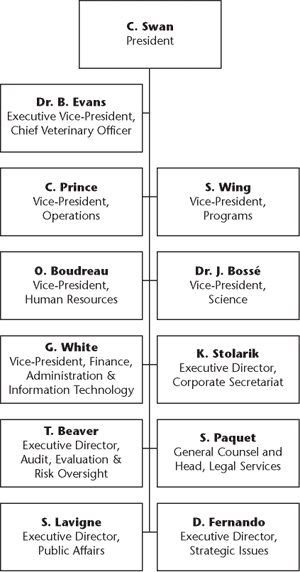
3.3 Regulatory Research
Regulatory Research activities support the CFIA’s mandate in food safety, animal health and plant protection. Regulatory research, as it applies to the activities of the CFIA, is focused on scientific investigation or analysis conducted by the CFIA, alone or with collaborating organizations, in order to produce new knowledge or new technology that addresses the specific needs or objectives of the CFIA. Research results aim to support sound, risk-based decision making, policy development and implementation, as well as program delivery.
The Regulatory Research Sub-Activities have been added to the CFIA’s 2006–07 Program Activity Architecture as outlined in the CFIA’s 2006–07 Report on Plans and Priorities.
Financial and human resources data, strategic indicators and targets are not available for this section for the current reporting year. In this section, we are reporting results for each expected result described in the 2006–07 Report on Plans and Priorities.
STRATEGIC OUTCOME: Protection from preventable health risks related to food safety or the transmission of animal diseases to humans
|
Program Activity: Food safety and public health Program Sub-Activity: Regulatory Research — Food safety, nutrition and public health Expected Result: Decision making related to food safety, nutrition and public health is supported by sound, sufficient and current Agency regulatory research |
Public awareness of food safety and nutrition continues to increase along with the global advancements in science. This trend has led to increased public focus on the safety and nutritional value of food. The scientific capacity to respond to new and emerging food safety and nutritional concerns is an important component of the CFIA’s inspection programs. Timely and defensible laboratory test results that will withstand legal and international scrutiny are key elements in the enforcement of food safety and nutrition compliance.
-
In 2006–07, the CFIA finalized the development of a diagnostic tool named Cloth-based Hybridization Array Systems (CHAS), which confirms the presence of four foodborne pathogens (Salmonella, E. coli O157:H7, Listeria monocytogenes and Shigella foodborne isolates).
Finalization of CHAS methods for other foodborne pathogens and inter-laboratory performance validation is expected in 2007– 08. This will provide the CFIA with more efficient analytical tools for use in its inspection programs for foodborne illnesses and shorter turnaround times for delivery of results. The CFIA also co-ordinated a databank of reference material to share this information throughout food microbiology laboratory networks across Canada to help in traceback investigations.
-
During the fiscal year, the CFIA also developed a confirmatory method to screen eggs for the presence of additional antibacterial drugs. For example, the availability of some drugs, especially through international sources via the Internet, means that the possibility exists for the presence of antibacterials in eggs after extra-label drug use, accidental use, or unauthorized use. The new method is used in conjunction with other CFIA screening methods.
Zoonotic diseases, by definition, have the potential to threaten public health. Some zoonotic diseases such as brucellosis, rabies, and bovine tuberculosis occur at a low level in Canada, especially in wildlife. Other diseases such as BSE and AI have emerged in recent years to threaten Canada’s agricultural economy, animal health and trade. Research to improve testing methodology contributes to reliable and accurate testing and facilitates disease control and early intervention should the disease appear in animals.
-
M. bovis is the causative agent of bovine tuberculosis, a reportable zoonotic disease in the cattle family with great economic impact. Determining how strains of this disease are related is important when planning disease control strategies and during outbreaks. The CFIA adopted new methods to determine the strain type for Mycobacterium bovis. This method appears to overcome many previous difficulties of past research.
STRATEGIC OUTCOME: Protection of consumers through a fair and effective food, animal and plant regulatory regime that supports competitive domestic and international markets
|
Program Sub-Activity: Regulatory Research — Exports and unfair practices Expected Result: Decision making related to regulatory development and review, deterring unfair practices, and export, is supported by sound, sufficient and current Agency regulatory research |
The CFIA research supports the delivery of a fair and effective regulatory regime for food, animals and plants through the acquisition of new knowledge and improved methodologies. The Agency’s research also supports consumer and marketplace protection from unfair practices by verifying that the methodology used to support regulatory compliance activities is fully validated, uses the best science available, is in line with international activities, and meets the requirements set out in Canadian regulations.
The CFIA, in collaboration with industry, worked on the potential validation of a DNAchip technology system for the identification of meat ingredients. Knowledge acquired allowed the CFIA to advise and guide the industry to improve the technology for use in North American food markets.
Agency research has also used new molecular technologies to differentiate DNA among varieties of potato. Accurate identification of potato varieties is useful in sustaining export markets and maintaining the high reputation of Canadian seed potatoes.
STRATEGIC OUTCOME: A sustainable plant and animal resource base
|
Program Sub-Activity: Regulatory Research — Animal and plant resource protection Expected Results: Decision making, including regulation, regarding animals and plant health are supported by sound, sufficient and current Agency regulatory research |
The CFIA’s research supports protection of the animal and plant resource base through the acquisition of new knowledge and improved technologies and methodologies for the prevention, detection, surveillance and management of animal diseases of significance to the health of livestock, wildlife, and plants. In addition, the CFIA’s research supports the harmonization of laboratory methods with trading partners.
The CFIA developed highly efficient and sensitive detection methods to test for Tobacco rattle virus and the tuber necrosis strain of Potato virus Y in potato samples. This resulted in the development of standard protocols for CFIA diagnostic laboratories and an increase in virus surveillance and risk analysis, which in turn increased the CFIA ’s capacity to address this area of emerging environmental and economic concern.
Research on transmissible spongiform encephalopathies (TSEs)
The CFIA conducts research to increase knowledge on transmissible spongiform encephalopathies (TSEs), including BSE and scrapie, which are found in Canadian livestock, and Chronic Wasting Disease, which is present in wild and farmed elk and deer. Research is focused on finding better ways to detect these diseases before signs become apparent, improve their control and protect animal health and trade.
To date, six different rapid tests for the detection of BSE have been validated, and samples on TSEs have been stored for future collaborative projects. These activities will continue in 2007–08.
Research on high-threat animal diseases
Exotic animal diseases such as foot-and-mouth disease and classical swine fever could devastate animal health and trade if they are introduced into Canada. The CFIA conducts research on these diseases to improve tests that allow for early detection and rapid response in the event of an outbreak.
In 2006–07, CFIA research activities with foot-and-mouth disease virus were initiated. Results include the production of highly needed diagnostic reagents and the development of new diagnostic tests that will ensure the CFIA’s ability to respond to an outbreak of this disease. This has allowed the CFIA to initiate proactive collaborations with other laboratories with similar interests. Through research, the CFIA will continue to work to develop a rapid “penside” diagnostic tool that would allow the testing of animals and animal products in situations where faster diagnosis is required.
STRATEGIC OUTCOME: Security from deliberate threats to Canada’s food supply and agricultural resource base
|
Program Sub-Activity: Regulatory Research — Public security (including the Chemical, Biological, Radiological and Nuclear Research and Technology Initiative) Expected Result: Decision making related to public security is supported by sound, sufficient and current agency regulatory research |
In 2006–07, CFIA officials continued to work on the creation of laboratory clusters for the Chemical, Biological, Radiological and Nuclear Research and Technology Initiative (CRTI), which supports Canada’s preparedness for, prevention of, and response to, chemical, biological, radiological and nuclear terrorist attacks. The CFIA also continued to co-chair the biological cluster of federal laboratories with the Public Health Agency of Canada.
Laboratory clusters focus on the joint needs of federal scientific laboratories and the operational community with respect to addressing potential chemical, biological, radiological and nuclear terrorist attacks. Through the clusters, representatives from federal departments and laboratories share their ideas, knowledge, experience and resources, as well as discuss challenges and solutions. The CFIA participated in the creation of a network of federal, provincial and university animal health diagnostic laboratories, which as a result of CRTI, will build on research findings and outcomes to enhance Canada’s ability to detect animal disease threats and provide a rapid response to minimize human health and economic consequences in the country.
Specific achievements over 2006–07 include the continued development of rapid, highly sensitive diagnostic tests for use during emergency responses to outbreaks of high-threat animal viruses, including avian influenza, which could be introduced into this country and transmitted to livestock, wildlife and, in some cases, to humans. Work also continued on the development of a web-based system to collect and process targeted surveillance data in order to disseminate intelligence among partners for rapid exchange of information and decision making. The system is expected to result in the seamless integration of human and animal health intelligence, and to provide a comprehensive solution set from data exchange to analysis, and from surveillance to alerting and event management.
The CFIA research continues to develop methodologies to detect potential contamination of the food supply. Examples include methodologies to detect Yersinia pestis (plague), Bacillus anthracis (anthrax), and ricin (a toxin that has potential to be used as an agent of biological warfare) in the food supply. The CFIA is also assessing newer technology and methodologies to improve its service delivery and capacity for the detection of pathogens in food. Projected to continue through 2007–08, the validation of the CFIA’s research methodologies for the detection of anthrax in specified foods is expected to be accredited by the Standards Council of Canada as official methods of Canada’s Quality Assurance Program. The validation data will provide crucial information on the sensitivity and specificity of the tests.
The CFIA is also developing new capabilities for rapid detection and typing of the potential agroterrorism agents, such as foot-and-mouth disease virus and avian influenza virus. In collaboration with CFIA stakeholders, DNA microarrays are being adapted to a more portable platform that can be easily and practically used by first emergency responders. This technology, named NanoChip technology, represents a novel detection and typing tool that can be used at the farm site in a mobile diagnostic unit. The CFIA has completed the assay design and layout on the NanoChip platform, and validation of the NanoChip electronic array technology is expected to be completed in 2008.
Through its involvement in all of these CRTI-related activities, the CFIA has strengthened its linkages with emergency response partners and enhanced its readiness to respond to terrorist attacks.
3.4 Providing Sound Agency Management
The CFIA views the implementation of the Treasury Board Secretariat’s (TBS) Management Accountability Framework (MAF) as a means to continuously improve its management processes so that its core mandate can be delivered in the most effective and efficient manner possible.
The MAF is a key part of the Treasury Board’s approach to improving management across federal departments and agencies. The framework is composed of 10 interconnected elements, such as risk management and accountability, which departments and agencies are expected to implement in their organizations to ensure management excellence and proper oversight of management practices. Every year, TBS assesses departments and agencies on their implementation of the MAF using more than 40 indicators.
Based on the TBS assessment of the management practices at the CFIA for 2005–06, the CFIA received the following ratings: five notables, 12 acceptables, one average, 10 opportunities for improvement, zero attention required, 14 unrated/ not applicable, and zero information required. This demonstrated an improved overall rating for the CFIA, moving up in eight indicators, down in one indicator, and maintaining its status for the remainder. In particular, the CFIA was commended for improving its ratings in the areas outlined in Table 3.4.1.
The CFIA was also praised for making progress in five priority management areas that were identified for follow-up in the 2004–05 TBS rating. These included: successfully integrating human resources into business planning; responding to common science-based human resources management issues by developing critical competencies for the science and technology community; and, mitigating financial pressures related to the management of animal and health emergencies using a contingency fund.
There were some areas, however, where the CFIA needed to improve its performance. For example, the CFIA was advised to address the under-representation of persons with disabilities, Aboriginal persons and visible minorities and to ensure that CFIA offices serving the public provide services in both official languages. It was also recommended that the CFIA improve its performance reporting by fully implementing the requirements of the TBS Management, Resources, and Results Structure (MRRS) Policy, and improve its governance structure by establishing a stable MRRS structure. In addition, the CFIA was asked to meet the Management of Information Technology Security Standard by December 2006 and establish firm target dates and prioritizing information and IT management activities.
The CFIA continues to actively address all MAF elements and indicators. Special priority has been made over the past year to address those areas that were deemed opportunities for improvement through the voluntary development of a MAF III Action Plan. The MAF Action Plan was presented and approved by the Executive Policy Committee and is updated on a quarterly basis through the Executive Sub-Committee on Planning and Reporting. The Action Plan was highly effective in increasing MAF awareness and engagement throughout the CFIA and has now been integrated as an ongoing best practice within the CFIA.
This section of the Agency’s Performance Report is presented according to MAF elements and indicators. Note: Resources attributable to Sound Agency Management activities are allocated from the CFIA’s four strategic outcomes on a pro-rata share.
3.4a Risk Management, Accountability, Governance and Strategic Directions, and Results and Performance
|
MAF Elements |
Indicators |
|
Governance and Strategic Direction |
Governance legitimacy Effective planning Portfolio management Governance structure Horizontal initiatives |
|
Risk Management |
Legal risk management Risk |
|
Accountability |
Authorities and delegation |
|
Results and Performance |
Evaluation function Information and decision making Financial reporting Performance reporting |
New Governance Structure
In 2006–07, the CFIA established a new governance structure that included the creation of two senior decision-making committees: one to oversee management and the other to drive policy direction. The Executive Management Committee is the forum for information sharing and updates on matters of ongoing interest and emerging issues. The Executive Policy Committee is the key point of integration for the CFIA, providing strategic policy direction for programs and administration, resource allocation, risk management and planning.
In the past year, the new governance structure has proven to be highly effective by enhancing communication, providing linkages amongst the various committees and ensuring that key issues are brought forth to the senior decision-making committees. To enhance the functionality of the governance structure, the CFIA has refined some of the processes required by these committees. These improvements include the development of a forward agenda, establishing regular meetings so that various committee chairs and committee secretariats can meet; development of a common look and feel for Records of Decisions (RODs); posting of executive subcommittee RODs on the CFIA’s Intranet site; and the creation of a database to capture all action items resulting from RODs. A review of each committee’s “Terms of Reference” and membership was completed to ensure that CFIA priorities are reflected and supported through a sound governance structure.
The CFIA has established an independent Executive Sub-Committee on Audit and Risk Management, which is chaired by the CFIA’s President. This sub-committee fulfills the terms and conditions of Treasury Board policies on internal audit and risk management. It also ensures independent and objective advice, guidance, and assurance on the adequacy of the CFIA’s control and accountability processes.
The CFIA Executive Council hosted a two-day conference for the CFIA executive community in February 2007. The conference focused on Celebrating Leadership. The conference highlights included a presentation from key industry partners, a panel discussion about perspectives of the CFIA’s federal partners as well as key messages from central agency leaders on workforce renewal and the strategic direction of the CFIA.
Integrated Risk Management
The CFIA, as a risk-based organization, continues to show its commitment to sound risk management by implementing Integrated Risk Management (IRM) principles throughout the organization. Integrated Risk Management is a continuous, proactive, and systematic process to understand, manage, and communicate risk from an organization-wide perspective. It is about making strategic decisions that contribute to the achievement of an organization’s overall corporate plans and priorities. Implementation of IRM within the CFIA is guided by the Treasury Board Secretariat’s Integrated Risk Management Framework and CFIA’s Integrated Risk Management Policy, which was recently developed. In 2006–07, the CFIA began the work required to update the Corporate Risk Profile. Workshops were held in all areas of the CFIA to identify, validate and rate risks as well as develop an inventory of existing mitigation strategies in the organisation. A new, high-level Corporate Risk Profile is scheduled for completion in the fall of 2007.
In the past year, consideration of key strategic risks was integrated into all decision-making and planning processes, including (but not limited to) strategic planning, regulatory analysis and capital planning.
Program Activity Architecture Review
The CFIA reviews its Program Activity Architecture on an annual basis, undertaking incremental revisions each year. In Budget 2006, the Government of Canada called for a renewal of the Government’s Expenditure Management System. This activity aims to ensure that federal programs focus on results, deliver value for money, are consistent with federal priorities, and continue to serve the purposes for which they were created. In 2006–07 the CFIA undertook an extensive review of its existing Program Activity Architecture to meet the objectives of this initiative as well as better reflect the Agency’s mandate. The result was the development of three Strategic Outcomes, which have been approved by Treasury Board. [The CFIA’s revised Strategic Outcomes and Program Activity Architecture structure will be implemented and reflected in the forthcoming 2008-09 Report on Plans and Priorities.]
Information Management/Information Technology Planning
Information Management (IM)/Information Technology (IT) planning is a key management priority for the CFIA. The TBS’s Management Accountability Framework (MAF) Assessment III for 2005–06 concluded that, at the time of the assessment, there was no information available on IM/IT governance structure, project execution or approach to common services. The assessment also concluded that the CFIA’s Management of Information Technology Security (MITS) plan needed to be refined to establish firm target dates for meeting compliance to the MITS Standard. As a result, the CFIA committed to set up a new Executive Sub-Committee on IM/IT; operationalize feeder committees to deal with IM/IT issues; and submit an MITS action plan, seek agreement from TBS, and validate the number of areas of MITS compliance commitments that the CFIA was required to address. Each of the action items undertaken in response to the TBS MAF Assessment III were completed by the end of March 2007 and will continue to be monitored and improved upon in 2007–08.
 Setting Targets and Performance Reporting
Setting Targets and Performance Reporting
Performance Management Framework
In 2006–07, the CFIA implemented a results oriented Performance Management Framework to improve data collection, management, and performance reporting. This framework was re-aligned to ensure consistency with the TBS Management, Resources and Results Structure Policy. The framework was also adjusted to respond to the recommendation of the Office of the Auditor General to include crosswalks between the program structure of the performance information and the Agency’s Report on Plans and Priorities and the CFIA’s Corporate Business Plan.
In particular, the Agency progressed in each of the following Performance Management Framework activity areas:
- Development of strategic indicators and targets: The CFIA improved collaboration across the Agency at all levels by establishing and leveraging key committees. It is expected that these committees will act as central nodes for information sharing between branch planning teams as well as for the implementation of best practices.
- Benchmarking on performance measurement: In response to the recommendations of the Office of the Auditor General, during 2006–07, the CFIA undertook a series of benchmarking exercises, examining and comparing the performance measurement practices of the CFIA and other similar international bodies. This information will be utilized to improve performance indicators and targets throughout the organisation as the CFIA continues its implementation of the Management, Resources and Results Policy through improvements to its Performance Measurement Framework.
- Performance management governance, guidelines, tools, training and communications: The CFIA integrated a new governance structure for performance management to enhance sound and collaborative decision making. The structure formalizes performance management as an established CFIA activity supported by management, building ownership within each branch and promoting further collaboration across the organisation. In 2006–07, the CFIA continued to build its performance management expertise, including training branch coordinators so they are better equipped to manage performance activities.
- Development of performance measures across all branches: In recognition that results-based measures must be integrated throughout the CFIA’s many branches and areas, the CFIA made a concerted effort to develop strategic and operational performance measures for all branches and regions.
- Performance management system mapping, cleanup, small improvements and upgrades: In 2006–07, the CFIA began a process aimed at identifying the gaps between corporate and strategic performance reporting. Reporting gaps have developed due to the utilization of different approaches for performance management and performance reporting, as well as the introduction of the revised Program Activity Architecture after the performance framework was established. This process will continue in 2007–08.
- Development and implementation of a longterm improvement strategy: The CFIA has been working to identify a long-term systems solution to support management reporting needs and to alleviate the challenges faced by users of the current system. In 2006–07, the CFIA focused on cleaning up core data and identifying ways to improve the reporting process and quality of data capture and reporting.
Access to information
In 2006–07, the CFIA implemented an Access to Information Action Plan (ATIP), which included making improvements to the InfoSource report and including data matching in its annual ATIP report. The CFIA achieved an “A” grade from TBS for its timely response to ATIP requests after it scored 95% on the ATIP report card.
3.4b People, Values and Learning
|
MAF Elements |
Indicators |
|
People |
Workplace Employment equity Official languages Readiness for PSMA implementation Workforce Human resources planning Performance review |
|
Values |
Leadership Organizational culture Guidelines and recourse |
|
Learning |
Innovation and change management Organizational learning |
Sustainable workforce
|
Representation |
2005–06 |
2006–07 |
|
Women |
49.3% |
50.39% |
|
Aboriginal peoples |
2.3% |
2.3% |
|
Persons with disabilities |
4.8% |
4.4% |
|
Visible minorities |
9.8% |
10.6% |
The CFIA recognizes that its success relies on the quality and ability of its employees and the sustainability of its workforce. To that end, the CFIA strives to ensure that it has sufficient resources to enable employees to do their jobs effectively. The CFIA is also committed to providing its employees with adequate and timely training, promoting diversity in its workforce, and ensuring that processes and practices are in place to resolve workplace issues.
The CFIA’s workforce grew from 6,121 in 2005–06 to 6,585 employees in 2006–07, an increase of 7.6%. This included an increase of 4.7% in the scientific, professional and technical community.
In 2006–07, the CFIA created a Youth Network (YN) to empower and retain young employees at the Agency, while promoting the CFIA as an employer of choice. The Youth Network developed Terms of Reference, engaged members from across all CFIA areas and developed an action plan and budget that was presented and accepted by EPC. The YN has been actively engaged in the CFIA, hosting brown bag luncheon information sessions and participating in various Agency-wide activities.
The CFIA plans, promotes and implements employment practices that encourage the full participation of diverse Canadians. The CFIA’s 2004 to 2007 Employment Equity Plan outlines goals to ensure that its workforce reflects the diversity of the Canadian population; progress in achieving these goals is measured annually.
In 2006–07, the CFIA made considerable progress toward sustaining a diverse and representative workforce. Representation of women, persons with disabilities and members of visible minorities have all reached 100% of the Canadian Workforce Availability, while the proportion of Aboriginal peoples is very close to this goal at 97%. Refer to Table 3.4b.1 for full representation breakdowns.
Moving Ahead on Key Challenges
Meet official languages obligations
The CFIA is working toward meeting the requirements of the Official Languages Act and the Agency’s official languages policies by implementing specific measures outlined in a three-year strategic plan. The CFIA is currently in the third year of its three-year strategic plan.
In 2006–07, the CFIA amended its Official Languages Policy to update and clarify its linguistic obligations and reinforce its commitment to serving Canadians in the official language of their choice. The CFIA also developed an accountability framework to outline the roles and responsibilities of its stakeholders with regard to Parts IV, V, VI and VII of the Official Languages Act. The CFIA also developed several new toolkits including one entitled Getting Ready for your Second Official Language Training to support employees in their second official language learning path.
Although the CFIA has made significant progress towards meeting the requirements of the Official Languages Act and the Agency’s official languages policies, there is still room for improvement. The TBS’ MAF Assessment IV for 2006–07 noted that the CFIA must continue its efforts to improve linguistic capacity in its offices with the obligation to provide service to the public in both official languages. The CFIA has committed to improving capacity to provide services in both official languages by 10% each year from 2006–09.
![]() Enhance the focus on learning, including implementing a prerequisite training program for new managers and developing additional e-learning products
Enhance the focus on learning, including implementing a prerequisite training program for new managers and developing additional e-learning products
The CFIA provides all employees with the training and tools they need to do their jobs, as well as the support to pursue career-long learning and development opportunities. The CFIA’s Learning Policy encourages a strong culture of continuous learning and provides direction to managers and employees on the management of learning.
In 2006–07, the CFIA offered a very successful Managing for Success training program to all 1,200 existing and 200 new managers. As part of its e-Learning initiative, the CFIA also launched a new e-Orientation program, e-Values program, and three science-based modules. In addition, the CFIA assessed leadership competency in all but two of its branches, the results of which were used to build branch-level learning strategies.
In support of its learning priorities, the CFIA increased its Development Fund to $2 million in 2006–07. This Fund supports knowledge transfer as well as management development including developmental official language training to meet succession planning needs. The Development Fund also provides for longerterm professional development and critical post-graduate opportunities.
The CFIA is also updating its meat hygiene learning modules to support its meat reform activities; has developed and implemented new training materials to support the avian influenza preparedness strategy; and is also delivering a scientific “train the trainers” course.
Launch second CFIA-wide employee survey
The CFIA conducted a second voluntary employee survey to gather views on its work environment and overall job satisfaction. The survey also sought employee opinion on changes that have occurred since the first survey was conducted in 2003.
A total of 54% of the CFIA’s employee population responded to the survey. The CFIA achieved strong positive results, with employee satisfaction increasing at least 5% in 42 of the 118 survey question areas, covering areas such as classification, staffing, performance management, career development, relations with immediate supervisors, harassment, and relations with the unions. Feedback, performance review and career development areas recorded improvement levels of 10% on average, and there was a 9% increase in employee satisfaction in questions related to staffing practices.
The CFIA is developing action plans to build on these achievements and to address opportunities for improvement revealed by the results of the employee survey. The CFIA is also using the results of the survey to apply a series of human resource metrics to further measure workplace wellness.
Integrate human resources planning into the business process
The CFIA integrates human resources planning into its business plans to improve its ability to forecast human resource needs.
In 2006, the CFIA provided training in this area to more than 1,400 managers as part of the Managing for Success pre-requisite training program for managers. The CFIA also developed a five-step integrated HR and Business Planning process to help its business planners and senior management identify their human resource priorities.
In addition, human resources planning sessions were held with the three main branches of the CFIA to identify HR gaps, challenges and potential solutions related to business priorities. The results of these sessions will be integrated into future branch business plans.
3.4c Policy, Programs and Citizen-Focused Service
|
MAF Elements |
Indicators |
|
Policy and Programs |
Policy framework Strategic policy capacity |
|
Citizen-Focused Service |
External service delivery strategry Official languages for external service delivery Government-wide services Service delivery and user fees |
Incorporating the principles of the Federal Accountability Act
The Federal Accountability Act, which entered into force in 2006, takes a “lead by example” approach to improving responsibility and accountability. The Act outlines its expectations of all federal departments and agencies, such as developing clear action plans and reports on progress in addressing recommendations of the Auditor General and enhancing budget information to respond to Parliamentary Budget Officer requests.
In 2006–07, the CFIA developed a detailed action plan that outlines each of the provisions of the Federal Accountability Act that are applicable to the CFIA, as well as how the CFIA must proceed in order to meet the commitments of the Act. To that end, the CFIA is now refining its internal control measures to support the President as an Accounting Officer and developing a new policy on transfer payments that is expected to be issued in 2007. The CFIA is also taking steps to create/adopt a policy on Values and Ethics and an internal policy on wrongdoing extending from the Public Servants’ Disclosure Protection Act.
Moving Ahead on Key Challenges
![]() Develop a consultation policy and database
Develop a consultation policy and database
To support the government-wide priority of transparency and accountability, the CFIA has worked over the past year to finalize its Consultation Policy. Consulting and engaging stakeholders in the development, implementation, review and evaluation of its policies, programs, services and initiatives remains an important priority for the CFIA. Progress was made in 2006–07 on the development of an electronic inventory/database of the CFIA’s consultations as well as a communications plan for the implementation of the framework.
![]() Continued implementation of the program delivery consistency initiative The TBS’s Management Accountability Framework Assessment III in 2006–07 concluded that the CFIA would benefit from improving responsiveness to client needs as well as partnering with other
jurisdictions or organizations to achieve more client-centric/cost-effective service delivery. In response, the CFIA committed to review the Consistency Initiative, with an aim to analyze and address areas of program delivery that require greater consistency across sectors. In 2006–07, the CFIA continued to measure its progress towards achieving consistency in the delivery of
its programs for meat, dairy, food safety and animal health; significant progress is being achieved through implementation of a QMS (Quality Management System).
Continued implementation of the program delivery consistency initiative The TBS’s Management Accountability Framework Assessment III in 2006–07 concluded that the CFIA would benefit from improving responsiveness to client needs as well as partnering with other
jurisdictions or organizations to achieve more client-centric/cost-effective service delivery. In response, the CFIA committed to review the Consistency Initiative, with an aim to analyze and address areas of program delivery that require greater consistency across sectors. In 2006–07, the CFIA continued to measure its progress towards achieving consistency in the delivery of
its programs for meat, dairy, food safety and animal health; significant progress is being achieved through implementation of a QMS (Quality Management System).
3.4d Stewardship
|
MAF Elements |
Indicators |
|
Stewardship |
Capital assets Financial analysis Information and IT management Internal audit function Management of transfer payments Materiel management Procurement and contract management Project management Quality of TB submissions Real property TB conditions |
Moving Ahead on Key Challenges
![]() Improve information and IT management
Improve information and IT management
The CFIA’s Information Management and Information Technology infrastructure must continually evolve to keep up with demand. The CFIA has been working at an aggressive pace on its Network Access Upgrade Project over the past year, to implement faster data telecommunication to its locations currently on dial-up.
In 2006–07, the CFIA made progress in the implementation of its Management of Information Technology Security Action Plan by developing information and processing capabilities to manage emergency situations. The CFIA also created an executive sub-committee on IM/IT to increase the focus on information management and information technology at the Agency, and to improve alignment of IM/IT within the CFIA’s business planning process.
![]() Implement the TBS Internal Audit Policy
Implement the TBS Internal Audit Policy
In April 2006, a new federal Internal Audit Policy took effect, aimed at strengthening public sector accountability, risk management, resource stewardship and good governance by reorganizing and bolstering government-wide internal audit.
The CFIA has adopted a proactive, incremental approach to the implementation of the policy over the next three years. Over the past year, the CFIA has been working on a business case to identify gaps in key systems, practices and controls, and to highlight areas requiring additional resources. Implementation of the policy is expected to be co-ordinated with other CFIA oversight measures.
3.4e Conclusion
Maintaining sound Agency management is the most important way that the CFIA can continue to reach each of its Strategic Outcomes. The CFIA is thus committed to continuously monitor and improve its management processes and to remain open to integrating new ways to improve the way the organisation functions. This commitment will ensure that the CFIA continues to exceed the expectations of Canadians for a safe food supply and healthy plants and animals.
3.5 Financial Performance
3.5.1 Reporting on Parliamentary Appropriations
Supplementary information on project spending can be found at www.tbs-sct.gc.ca/dpr-rmr/0607/info/ps-dp_e.asp
Statutory Compensation Payments — Supplementary information on the CFIA’s Transfer Payment Programs can be found at www.tbs-sct.gc.ca/dpr-rmr/0607/info/ps-dp_e.asp
Supplementary information on horizontal initiatives can be found on the TBS website at www.tbs-sct.gc.ca/rma/eppi-ibdrp/hrdb-rhbd/profil_e.asp
Electronic Link to Reports: www.inspection.gc.ca/english/agen/eval/evale.shtml

